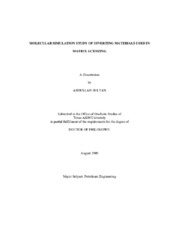| dc.description.abstract | Recently there has been a great deal of attention in the oilfield industry focused on the
phenomenal properties of viscoelastic surfactants (VES). The interest is motivated by
their applications as switchable smart fluids, their surface tension, and their thickening
and rheology enhancement in aqueous solution. Surfactant molecules in solution are
known for their ability to assemble spontaneously into complex structures. Under certain
thermodynamic conditions, temperature and electrolyte concentrations, wormlike
micelles are formed. These micelles share similar equilibrium and dynamic properties
with polymer solutions, However, micellar chains can break and recombine
spontaneously which make them part of the more general class of living polymers. It is
vital to understand the properties of viscoelastic wormlike micelles with regard to their
flow in porous media.
The overall objective of this study is to establish a better understanding of counterion
effect on behavior of VES. The dependence of macroscopic properties on intermolecular
interactions of complex fluid systems such as VES is an enormous challenge. To achieve
our objective, we use first-principle calculations and molecular dynamics (MD)
simulations to resolve the full chemical details in order to study how the structure of the
micellar and solution properties depends on the chemical structure of the surfactant head
group (HG) and type of counterion. In particular, we run simulations for different
structures in gas-phase and aqueous solutions together with their salt counterions at room temperature and atmospheric pressure. For this purpose, we consider four types of
surfactant HG (anionic, cationic, betaine and amidoamine oxide) together with the most
common ions present in the acidizing fluid of a carbonate reservoir such as Ca2+, Mg2+,
Fe2+, Fe3+, Mn2+ and Zn2+, Cl-, OH- and HS-. Hydration of ions as well as interactions
with surfactant the HG are studied using density functional theory (DFT). The results
give important insight into the links between molecular details of VES HG structure and
observed solution properties. This study proposes for the first time the possible
mechanisms that explain the exotic behavior of VES at high Fe(III) concentration. Also,
our MD simulation suggests that distribution of chloride ion around surfactant molecules
is responsible for their viscosity behavior in HCl solution. We believe that our results
are an important step to develop more systematic procedures for the molecular design
and formulation of more effective and efficient VES systems. | en |


